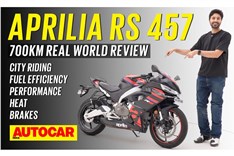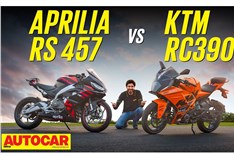Aprilia RS 457 vs Yamaha R3 comparison
Looking for a reasonably affordable twin-cylinder sportbike? We help you pick between two great choices.
Published on May 25, 2024 07:00:00 AM
53,717 Views
Follow us on
Last month we shared what the Aprilia Rs 457 was like on track vs the venerable KTM RC 390. This month, the story is about how it does on the road vs another tried and tested rival, the Yamaha R3.
EASY ON THE EYE
The updated R3 has that typical sharp Japanese sportbike look with a handsome face and a sharp looking tail section. It’s a good looking thing, but it does appear a bit small compared to the RS 457, which is remarkably similar to the bigger machines in Aprilia’s line-up.

The RS 457 looks smashing, not just from a distance, but also when you sit on it. I’ve said this before, but this really feels like a scaled down big bike rather than a grown up small bike. You’ll feel that in the sheer size of the fuel tank (although it holds just 13 litres) as well as the wide handlebar placement. This also extends to the riding position where the wider Aprilia feels like a size up compared to the slim R3 with its narrow clip-on handlebars.
While it comes across as more substantial, the 457 also has the go to match the show. But before we get to performance, let’s talk about sound, because this is probably important if you’re buying a twin-cylinder bike.
SOUND AND SPEED
The R3 makes a familiar sound and while it’s pretty unconventional at low revs, it sounds excitingly good when you rev it out. In fact, at max revs, it might even be louder than the Aprilia. However, the RS 457 belts out a note that no bike in this segment has before. That 270-degree firing order has given this engine a surprisingly deep sound with an intoxicating bark that sounds good at pretty much any rpm.
So that’s the sound. Now let’s talk about the speed. Simply put, the RS 457 is the fastest locally manufactured motorcycle we have ever tested. And it’s not just flat-out acceleration that impresses, because the RS 457 has a strong mid range as well, and it responds well from right above 3,000rpm. The difference shows in our roll on tests and the rich mid range helps the Aprilia feel quicker at all points.
But that isn’t to say the R3 is a slow bike by any means. It still hits a sub-6sec 0-100kph time and it has a much more thrilling top end rush, but it will be left behind in this company. Both bikes will hit a speedo indicated top speed of 180-190kph, but the R3 has quite a bit more speedo error than the Aprilia.

As for refinement, both engines are smooth at lower revs but the Yamaha produces a stronger buzz at higher revs. As you’d expect, the R3 is more fuel efficient, and it surprised us with how efficient it can be. Meanwhile, the Aprilia’s efficiency in the city was also surprising, but its highway figure isn’t bad.
The stock R3 is a very neutral and engaging handler, but when you push it hard, the soggy rear shock and average Dunlop tyres let it down. With some modifications, it has the potential to be a great track motorcycle, but the Aprilia is the better handler right out of the box.
The 457 is sharper and more engaging with excellent feel and feedback. Its aluminium chassis feels more taut and the same goes for the suspension, which gives the bike a more controlled feel at high lean angles. The Aprilia’s TVS Eurogrip tyres also feel much more grippy and trustworthy, and you know that there’s a bigger electronic safety net watching out for you on the Aprilia.

The Aprilia’s brakes are also sharper, although the stock brake pads can overheat under repeated hard braking conditions. Nevertheless, the Aprilia is not only the more sporty-feeling bike here, but it is effectively the most capable sportbike available under Rs 5 lakh.
A QUESTION OF COMFORT
The flip side is that it is not a very comfortable bike. While the suspension is not as plush as the R3, it still does a reasonably good job of absorbing smaller bumps. But the more committed riding position along with the firmer rear shock and hard seat ensure that you feel much more of the road. And in a city like Mumbai where the roads are mostly lumpy and bumpy, that feeling is pain. If regular riding on less than ideal roads is important, then the R3 is the bike for you.

That being said, the RS 457 does have some advantages in the city. Its steering feels lighter and you need to put less effort into turning the handlebar from side to side. Mostly though, the Aprilia has a beautifully light clutch that’s far less tiring than the Yamaha’s.
Both engines are very tractable and you can ride around in higher gears at low speeds without any complaints. Both also manage engine heat quite well and while you’ll feel some warmth, neither engine ever threatened to overheat, even in heavy rush-hour traffic.
DIFFERENT TAKES
When it comes to features and technology, the Aprilia feels ten years younger than the R3 and that makes sense because not a lot has changed on the Yamaha since it debuted in 2015. The latest R3 gets an upside down fork and that new face along with a revised fairing, but the rest is mostly the same. This means that you don’t get much more than dual channel ABS – no traction control, no TFT display and not even a slip assist clutch.

The Aprilia has much more to offer, including a lovely looking TFT display, three different levels of throttle response, three levels of traction control and switchable ABS. It also has Bluetooth compatibility with navigation. There were a couple of times when the screen was a bit unresponsive to button inputs and it occasionally showed some pixels, which disappeared on an ignition off-on cycle, but those were the only glitches we’ve faced with the bike so far.
It comes as no surprise that the locally manufactured Aprilia is more affordable than the CBU import Yamaha. However, we do wish that the Aprilia was slightly more affordable, especially given that its accessory quickshifter will cost you around Rs 28,000. But when compared with the Yamaha, there is no shaking the fact that you’re getting a lot more for quite a lot less.
MONEY MATTERS
While it seems like a complete washout for the Yamaha, it’s important to remember that you’re not buying a brochure, you’re buying a motorcycling experience. This bike gives you a great one, especially if you like your machines simple and straightforward.

The R3 is still a very quick and fun bike, but it’s also practical, comfortable and usable, even in a tough environment like ours. And of course, there’s the proven reliability. So for some people, the Yam will make more sense. But that’s only if you’re willing to pay a lot more money, especially in states like Maharashtra that tax CBUs at a higher rate.
For everyone else, the RS just gives you so much more. Most of all though, it’s a more special feeling motorcycle, in the way that it looks, sounds and rides. Aprilia still has to prove this bike’s sales and reliability, but for now, they’ve hit it out of the park and this is an awesome little thing.
Also See:
Aprilia RS 457 vs Yamaha R3 comparison video

Copyright (c) Autocar India. All rights reserved.









Comments
Member Login
Personal Details
No comments yet. Be the first to comment.